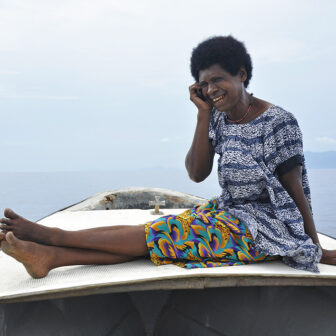Inside the Greens: The Origins and Future of the Party, the People and the Politics
By Paddy Manning | Black Inc. | $34.99 | 560 pages
Almost without exception, Australian politics has been unkind to third parties. The nation’s political history is a graveyard of failed projects, many of which began with a sense of urgency, optimism or even destiny. Life expectancy is short, death seemingly inevitable. If a small number of them survive in the country’s memory, they are largely seen as historical curiosities.
At this point at least, the Australian Greens appear to be cheating this fate. While the party’s growth might have fallen short of more buoyant projections, it now seems to have built the foundations of stability: a sturdy social base, an active and tribal membership, and seats across the country’s state and federal parliaments. Just as tellingly, perhaps, it has acquired features associated with successful parties, including creeping factionalism, simmering personal feuds, and a tendency to litigate these internal disagreements through the media. The party is all grown up.
Paddy Manning, author and political journalist, maps this gradual rise to influence — from protest to parliament — in Inside the Greens. As a general history, it is a much-needed work: comprehensive, detailed and impressively sourced. While parts of this story have been covered elsewhere, Manning succeeds in pulling together the scattered narrative, while adding considerable original evidence and interview material. It is the first book to really chronicle “how the Greens began and grew in Australia, who they are now, and where they are going.”
Inside the Greens opens with the protesters who greeted US president Lyndon Johnson’s visit to Sydney in 1966. There that day were two future senators: a teenage socialist, Lee Rhiannon, and a conservative medical student, Bob Brown, who was attending the welcome parade in earnest. In a lengthy examination of the party’s origins, Manning follows its journey down two paths, one through the overlapping minor parties that preceded the Greens, the other through the extra-parliamentary fights that spurred its eventual creation.
The first strand is particularly fascinating. Here we see the rise and fall of the Australia Party, the Nuclear Disarmament Party and the Australian Democrats. While they were often more moderate than the Greens, they shared an emphasis on conservation and social liberalism, combined with a deep scepticism about the bureaucratic organising model of major parties. Memberships often overlapped. Each was simultaneously ally and rival, providing a glimpse into the emerging green politics but also presenting a barrier to its full realisation.
The environmental struggles are well known. With enviable access to the main players and their private papers, Manning recounts the battles to save Lake Pedder and the Franklin River, the fight against pulp mills in Tasmania, the Victorian push to halt forestry in East Gippsland, and the blockade against uranium mining at Jabiluka. (Each attracted future Greens representatives: Bob Brown, Christine Milne, Janet Rice and Scott Ludlam all rose through the campaigns as activists.) And while these chapters offer partisan rather than definitive accounts, the interviews provide vivid insights into the Greens’ worldview, revealing their cast of villains, their consistent tactics and their broader understanding of politics and political conflict.
The Greens are a stubbornly federated party — the Western Australian branch only joined the national organisation in 2002 — and Manning deftly weaves together the varied and uneven state experiences. He shows how early success propelled the Tasmanian branch into the centre of national discussion while the Queensland party was struggling to gain parliamentary traction. For their part, the Western Australians grew out of the imploding Nuclear Disarmament Party, just as the NSW branch emerged from urban left politics and the end of the cold war. These early differences left an imprint, creating distinct cultural identities across the state organisations. Some proved more successful than others.
At least at the federal level, the party’s decisive electoral breakthrough coincided with the collapse of the Democrats. This partly reflected that party’s internal disintegration, but it was also a result of the Greens’ more coherent left-wing pitch. Throughout the 2000s, its politicians were unambiguous and vocal on some of the era’s defining issues, particularly the Pacific Solution and the Iraq war. (Brown famously heckled George Bush during his address to the Australian parliament in 2003, an incident recounted here in detail.) By Kevin Rudd’s election in 2007, the party had a solid foothold in the Senate — and, by 2010, it possessed a vote in Julia Gillard’s minority government as well as the balance of power in the Senate.
Electoral success gave the party a new, and at times uncomfortable, intimacy with political power, and Inside the Greens examines these experiences at federal and state levels. Common themes emerge, connected by an almost existential concern: how should a party interact with forces that, for most of its history, it considered corrupting and suspicious?
For early Greens politicians like Christabel Chamarette and Dee Margetts, who held vital Senate seats during the Keating years, this question was both pressing and practical. Exactly how much should they demand in exchange for their support, and at what point should they remove it altogether? In 1993, Chamarette went very close to voting down the Native Title Act, claiming it did not go far enough in securing Indigenous ownership. (Her resistance was so obstinate that, as the debate dragged on, she began receiving supportive letters from racist opponents of the bill.) Twenty years later, the federal party would experience a similar dilemma on climate policy — first voting down Kevin Rudd’s scheme, later negotiating with Gillard to legislate carbon pricing.
Other considerations are more strategic. The party’s most rapid periods of popular growth have tended to occur while firmly outside the tent of government. Conversely, minority government under Gillard might have given the Greens unprecedented influence — a seat at the table that produced carbon pricing — but it was ultimately at the expense of electoral growth. Over that period, the federal party lost a third of its vote, and after a similar experiment, the Tasmanian branch lost even more. As Manning shows, the party is still unsure of what to do with this information, particularly if the trade-off between power and popularity is unshakable.
Running beneath this dilemma is a deeper question of purpose and ambition. Inside the Greens is littered with grandiose predictions made through the years — of winning dozens of seats in the House of Representatives or even replacing Labor altogether. Fair enough: this is politics; dream big. But it is often hard to tell how serious these goals are, or how they inform the party’s behaviour and strategy. Perhaps, like much of Bob Brown’s rhetoric, it combines irony and earnestness — a distant and flickering light on the hill.
Still, even with failed KPIs, the party’s expansion has been steady and durable. It now possesses dozens of seats in Australian parliaments, a small class of staffers and operatives, and the resources needed to run targeted campaigns. Stewart Jackson, a former state convenor of the Greens and now scholar of the organisation, describes this as a transition from movement politics to electoral professionalism. While the spoils of parliament can change a party — shifting power from grassroots members to elected officials — thicker institutional roots mean the Greens are less vulnerable to disturbances and shocks. In important ways, the party has assumed the air of permanency.
The book’s second half examines some of the internal pains associated with this growth. Here things get more controversial. While the party’s state branches have always been in tension — with Tasmanians advocating a centralised national organisation, for instance, and the NSW group holding tightly onto local autonomy — this has become particularly vicious and public in recent years. And, as Manning has examined elsewhere, these differences overlap with other, more ideological disagreements between the party’s socialist and environmentalist tendencies — disagreements that also exist within individual states.
Inside the Greens provides the most detailed coverage of these internal disputes currently on the public record. Two in particular receive extensive attention. The first is the recent saga over NSW preselections, initially after the death of John Kaye in 2016 and then in preparation for the 2019 state campaign. The book shows how an already brutal ballot escalated when a former party member accused Jeremy Buckingham, a moderate Green, of sexual assault — an allegation Buckingham denies. This is sensitive terrain, blurring personal, political and criminal considerations, and Manning is careful to present multiple perspectives. It was an ugly affair, as the book makes clear, and still reverberates through the state party.
The second major clash helped bring down the party’s Batman by-election campaign in 2018. While the NSW preselections reflected ongoing philosophical disagreements, this was self-sabotage at its most mindless, driven by local gossip and council ambitions. Jealous local members leaked against the party’s candidate, Alex Bhathal, accusing her of bullying and factional thuggery. As Manning suggests, these claims were fanciful and opportunistic — making Bhathal’s already difficult battle impossible. The book quotes at length journalist Martin McKenzie-Murray, who is even more dismissive of the discontents after reading the evidence of the “bullying”:
The real corruption to be found in the voluminous records of micro-aggressions is of language. Disagreement becomes abuse. Debate is violence. Ordinary requests are bullying. Frivolity is recklessness. I have encountered sensitivity so pronounced, so easily disturbed, that it resembles madness. And I detect in this hypersensitivity an imperious individualism, an almost hysterical primacy of one’s feelings — impractical in a political party and disastrous for the communal values of debate.
The book ends with a long, discursive conversation with prominent Greens politicians about the future of Australian politics and the party’s policy direction. The contrast with the factional brawling is glaring. While different figures present different priorities, suggesting distinctive postures and messaging strategies, for the most part they form a unity ticket. On climate change, social policy, war and democracy, they chart broadly left positions, with an implicit belief that history will validate them. As Manning argues in the book’s final pages, the party’s future will be defined by its navigation through these twin currents: between the sporadic, often bitter internal battles, and what Greens activists consider their vital, still-ripening political mission. •




